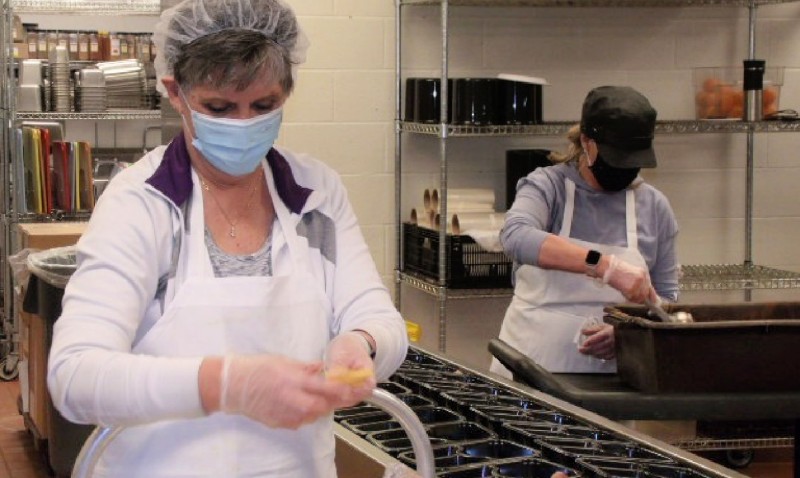On a bone-chilling February morning, SourcePoint’s Meals on Wheels volunteers maneuver their vehicles into the drive-thru lane, lining up to have their trunks, hatches, and truck beds loaded with coolers before heading out on snowy delivery routes. While many volunteer activities are on hold during the pandemic, meal delivery has ramped up. As essential as the drivers are to this vital program, they are one part of the team that has carried homebound Delaware County seniors through the longest winter in recent memory.
Hours before the 10:30 a.m. assemblage of drivers, three volunteers cross the cold parking lot in the dim morning light. They are welcomed into SourcePoint’s warm and bustling kitchen by chefs and prep cooks who, at 7 a.m., are well into their daily meal preparations. The volunteer “packers” don aprons and hairnets and get to work lining up empty plastic trays on the Oliver—the assembly line conveyor that moves the trays along towards a sealing mechanism. There is an “I Love Lucy” vibe as they work side-by-side on the line.

Becky Nitz, Tracy Brannon, Lora George
The packers chat companionably from behind facemasks, something Lucy and Ethel never had to worry about. “Time goes fast,” said volunteer Becky Nitz. “We all become really good friends.”
“We also get to know how much work the kitchen staff does,” said fellow packer Tracy Brannon. “They are helpful and educational.”
“You can tell they really care,” Becky agreed. “They make sure the portions are right and the meal is made right. They care about the volunteers and the people they serve.”
Becky, Tracy, and a third packer, Lora George, fill each of the trays’ compartments with ginger-glazed salmon, basmati rice, and curried vegetables. The menu reads as if from a Cameron Mitchell restaurant, not the kitchen of an aging services provider. “The food looks delicious,” said Becky. “Makes you hungry!”
Once the trays emerge from the sealer, each gets a hand-applied sticker indicating a “hot” meal. The trays are chilled overnight, then delivered piping hot the next day just in time for lunch. “It’s hard work,” said Becky. “And it’s very rewarding. Not only rewarding, but fun.”
By 8 a.m., the nutrition staff are at their desks and on their phones and computers, mobilizing the forces for today’s efficient county-wide meal delivery. A community member has gifted the department with a box of oversized cookies, a random act of kindness that elicits squeals of delight.
On the other side of the nutrition office’s glass walls, the kitchen staff is preparing the loading area, where a wall of ovens brings the refrigerated meals up to a safe temperature.

Volunteer Dean Prall
Another volunteer, Dean Prall, arrives and has his temperature taken at the door. He moves quickly to arrange the area where he will pack the coolers with beverages and side items. The work is fast, but the count must be accurate, or a hungry senior’s lunch might be shorted. Once the filled coolers are organized on three-tiered racks under the names of each of the 34 meal routes, the volunteer moves on to his next task, sorting the delivery instructions onto clipboards for each of the meal drivers to take on their route. Once again, the volunteer must work with both speed and accuracy to get the meal drivers on the road with the right paperwork.
“Keeps me busy,” said Dean. “I’ve always volunteered a lot, but most of the opportunities ended with the pandemic.” A veteran of the U.S. Army, Dean has been active in Honor Flight and USO, as well as serving on the City of Delaware Planning and Development Commission and volunteering at his son’s school. “My mom got Meals on Wheels before she passed away, so I thought I’d try this.”
Back in the kitchen, a fourth packer arrives to pack the specialty trays—carb-controlled, low-sodium, chopped and pureed—as Becky, Tracy, and Lora prepare the Oliver with a line of trays that will hold the next day’s cold meals. These are delivered with the hot lunches and refrigerated until dinnertime. By the time they finish, 1,000 or more meals trays are packed, sealed, stickered, and in the cooler for the next day’s delivery.
By 10 a.m., a sense of controlled chaos takes over the loading area. Heavy metal carts form an irregular line, snaking between the tall racks of coolers. Steaming trays emerge hot from the ovens and are quickly counted and packed with the continued theme of speed and accuracy. More volunteers, the “runners,” arrive. Two nutrition staff members bundle up and head outside to greet the line of volunteer drivers. One will sign them in on an iPad as the other directs the flow of traffic, simultaneously giving instructions and encouragement. Both will stomp their feet and wiggle their fingers to stay warm.

Loading Area
The pandemic necessitated a change in the way meal drivers are sent off on their routes. Gone are the days when drivers came in the building for a cup of coffee and friendly conversation before carting out their own coolers. That gathering is clearly missed. This February morning, a few meal drivers line up early, stepping out of their parked vehicles for a socially distant “How’ve you been?” with their masks covering warm smiles and rosy noses.
Inside, the runners wait behind the metal carts now loaded with coolers. A staticky voice from a walkie-talkie fills the interior space with, “Ashley’s on deck, Shawnee is in the hole,” like a coach queuing up the team’s batters. A blast of cold air hits the runners as each pushes a loaded cart through the doors and out to the corresponding vehicles. The drivers stick their heads out their car’s window or turn to speak through the open hatch to indicate their loading preferences. The runners close trunk lids and hatches with practiced gentleness and hand clipboards through the drivers’ windows. They return the empty carts to the line to be reloaded before the next wave of drivers.
Woven in between the work is the fun. “We love to watch the dynamics between the different generations of volunteers as they work and enjoy ‘safe’ lunch breaks together,” said staff member Sonya Delany. The runners on this particular day are Kathy Heinz, a retiree, and Brody Brown, a student at Olentangy Berlin High School. Kathy displays grandmotherly dismay at Brody’s lack of a coat, to which he responds with a classic teenage shrug. Inside, Dean and John Burrer, a staff van driver, banter about the upcoming OSU vs. Michigan game as John prepares to deliver meals to a remote part of the county.

MOW Drivers Kathy Heinz & Brody Brown
The last of the meal drivers depart a little before 11 a.m. At their various stations, volunteers and staff share a collective sense of mission accomplished. The kitchen packers have finished up and can grab a lunch to take home or eat together at separate tables. The runners catch their breath and warm up with a hot meal. Some use this time to report down the hall for their bi-weekly COVID test—an essential but unwelcome mandate for all on-site staff and volunteers.
By noon, the kitchen is spotless and calm, with just staff remaining to plan and prep for future meals. The nutrition office has converted to an active call center as drivers report issues or clients call in with questions or menu changes. The runners wrap up their lunch and watch the door for returning drivers, then dash out to relieve them of empty coolers and clipboards. They pause next to rolled down windows, listening to the drivers’ concerns for the well-being of some of their homebound senior clients. The concerns are noted and shared with each client’s care consultant for further investigation.
An hour later, most drivers have made a triumphant return from their meal routes and are heading home. Before they leave, each are offered a take-home lunch to enjoy for themselves. The runners stack the empty coolers on racks, wipe everything down and sign out. They wave goodbye to the staff with, “See you next week!”

